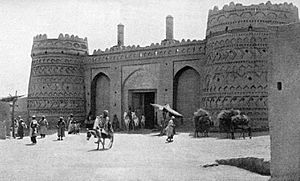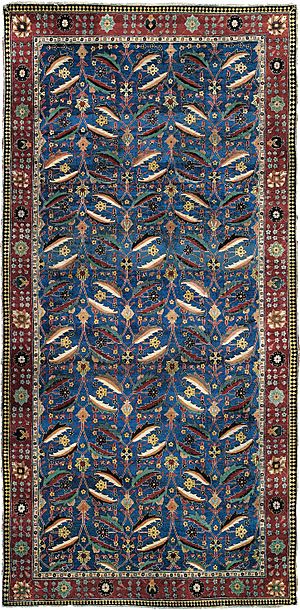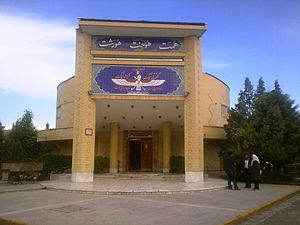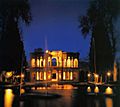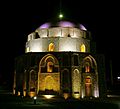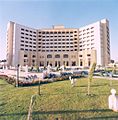Kerman facts for kids
Quick facts for kids
Kerman
|
|
|---|---|
|
City
|
|
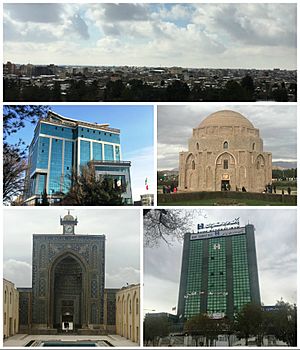
Left to right: Bazaar of Kerman; Great Library of Kerman; Ganjali Khan complex; Jameh Mosque; Jabaliyeh dome, an ancient museum of stone
|
|
| Nickname(s):
The City of Stars
|
|
| Country | |
| Province | Kerman |
| County | Kerman |
| Bakhsh | Central |
| Founded | c. 3rd century AD |
| Area | |
| • City | 220 km2 (92.22 sq mi) |
| Elevation | 1,755 m (5,758 ft) |
| Population
(2016 Census)
|
|
| • Urban | 738,374 |
| • Population Rank in Iran | 10th |
| Demonym(s) | Kermani |
| Time zone | UTC+3:30 (IRST) |
| • Summer (DST) | UTC+4:30 (IRDT) |
| Postal code |
761
|
| Area code(s) | +98 343 |
| Main language(s) | Persian |
| Climate | BWk |
| Website | www.kermancity.ir/index.php/en/ |
Kerman is the capital city of Kerman Province, Iran. At the 2011 census, its population was 821,394, in 221,389 households, making it the 10th most populous city of Iran.
It is the largest and most developed city in Kerman Province and the most important city in the southeast of Iran. It is also one of the largest cities of Iran in terms of area. Kerman is famous for its long history and strong cultural heritage. The city is home to many historic mosques and Zoroastrian fire temples.
Kerman became the capital city of Iranian dynasties several times during its history. It is located on a large, flat plain, 800 km (500 mi) south-east of Tehran, the capital of Iran. For Iranian paleontologists, Kerman has always been considered a fossil paradise. The discovery of new dinosaur footprints in 2005 renewed hopes for better understanding the history of this area.
Contents
History
Kerman was founded as a defensive outpost by Ardashir I, founder of the Sasanian Empire, in the 3rd century AD. After the Battle of Nahāvand in 642, the city came under Muslim rule. At first the city's relative isolation allowed Kharijites and Zoroastrians to thrive there, but the Kharijites were wiped out in 698, and the population was mostly Muslim by 725.
Already in the eighth century the city was famous for its manufacture of cashmere wool shawls and other textiles. The Abbasid Caliphate's authority over the region was weak, and power passed in the tenth century to the Buyid dynasty, which maintained control even when the region and city fell to Mahmud of Ghazni in the late tenth century. The name Kerman was adopted at some point in the tenth century.
Under the rule of the Seljuq Turks in the 11th and 12th centuries, Kerman remained virtually independent, conquering Oman and Fars. When Marco Polo visited Kerman in 1271, it had become a major trade emporium linking the Persian Gulf with Khorasan and Central Asia.
Due to this the city was sacked (looted) many times by various invaders. Kerman expanded rapidly during the Safavid dynasty. Carpets and rugs were exported to England and Germany during this period.
In 1793 Lotf Ali Khan defeated the Qajars, and in 1794 he captured Kerman. But soon after he was surrounded by armed forces in Kerman for six months by Agha Mohammad Khan Qajar. When the city fell to Agha Mohammad Khan, angered by the popular support that Lotf Ali Khan had received, many of the male inhabitants were killed, women and children were sold into slavery and in ninety days the city turned into ruins. The Zoroastrians of Kerman who had been strong supporters of Lotf Ali Khan suffered the wrath of the founder of Qajar dynasty the most during this period.
The present city of Kerman was rebuilt in the 19th century to the northwest of the old city, but the city did not return to its former size until the 20th century.
Economy
The economy of Kerman is mostly based on farming, notably nut farming and also mining. Sarchashmeh Copper mine is the second biggest copper mine in the world. Pistachios are an important part of the economy in Kerman, with Kerman Province being the largest producer of pistachios in Iran and the world.
Carpet weaving is one of the main industries of the city, and the carpets produced there are renowned internationally. Carpet weaving is a very old tradition in Kerman. The oldest carpet discovered in Kerman, dates from about 500 years ago. Cotton textiles and goats-wool shawls are also manufactured. A number of modern establishments such as textile mills and brickworks also have been constructed. The province's mineral wealth includes copper and coal.
Kerman is one of the leading cities in Iran in the field of health and many people from neighboring provinces visit the city for medical care.
Culture
Kerman is among several cities in Iran with a strong cultural heritage, which is expressed in the local accent, poetry, local music, handicrafts and customs that Kerman has introduced to the world.
The only anthropology Iran museum of Zoroastrians in the world, which showcases the ancient history of Zoroastrians, is in Kerman’s Fire Temple. The museum was officially inaugurated in 2005 by Iran’s Cultural Heritage, Handicrafts and Tourism Organization (ICHHTO).
Jashn-e Tirgan or Tiregan is an ancient Iranian rain festival observed on July 1. The festivity refers to archangel Tir (literally meaning arrow) or Tishtar (lightning), who appear in the sky to generate thunder and lightning for providing much needed rain. The Sadeh ceremony is celebrated every year in Kerman.
Also, the archeological ancient areas of Jiroft and Tappe Yahya Baft are located south of Kerman. Rayen Castle is also located in Rayen town, southeast of Kerman.
Some of the handicrafts and souvenirs of the province of Kerman are traditional embroidery known as pateh, carpets, rugs, jajeems, Kilims (a coarse carpet), satchels, and other hand woven articles. Caraway seeds and pistachio of Rafsanjan and Kerman are best of the main items of this province.
Images for kids
-
Kerman's Grand Bazaar
See also
 In Spanish: Kermán para niños
In Spanish: Kermán para niños



